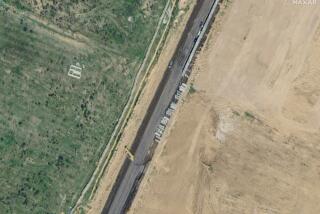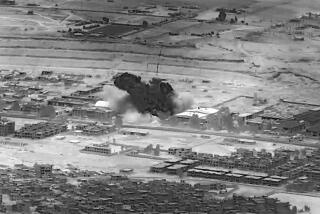‘Casualties’ Top 50% as GIs Stage Mock Frontal Attack : Military: Analysts predict that U.S. won’t mount a full-scale assault against strongest part of defenses.
- Share via
WITH U.S. FORCES IN SAUDI ARABIA — American troops, preparing for possible war, have begun practicing assaults on replicas of the massive Iraqi fortifications that they might have to storm, and in some of those exercises projected casualty rates have exceeded 50% killed or wounded, knowledgeable military sources said.
American combat engineers, working from satellite photographs and other intelligence data, have built full-scale models of the Iraqi positions and will soon add trenches flooded with blazing oil--a grim feature of the defenses Baghdad has erected along the Kuwaiti border.
When soldiers launched attacks on these fortifications, the results have starkly underlined the potential costs of a ground war against the more than 270,000 Iraqi infantrymen dug into elaborate positions that stretch the full length of the Kuwaiti border and about 100 miles into Iraq itself.
In one recent exercise at a California military training ground, a brigade-size Army unit of almost 2,000 men was ordered to breach a “triangular strongpoint” occupied by a far smaller mock-Iraqi unit. The American force “lost” roughly one-third of its numbers, a full battalion, sources said.
Based on the results of about 180 brigade-sized mock-battles against these and similar fortifications, the Marine Corps recently told its members that “losses to breaching efforts can run over 50%.”
Military analysts predict that U.S. forces will not mount a full-scale frontal attack against the strongest portions of the Iraqi defenses. Instead, they are expected to use aerial and artillery bombardments to soften the enemy lines, then employ flanking movements and other tactics to exploit vulnerabilities.
Nonetheless, the fortifications are so extensive and deep that--barring a complete collapse of President Saddam Hussein’s forces early in any conflict--U.S. and allied commanders believe that they will have to penetrate some parts of the Iraqi lines.
“At the end of the day,” said Brig. Gen. Christopher Hammerbeck, commander of a British army brigade here, “I think we’ll have to throw them out.”
In anticipation of the need, exercises using detailed mock-ups of the Iraqi defenses have been conducted both in Saudi Arabia and at the Army’s National Training Center at Ft. Ord.
Operation Desert Shield commanders recently directed military engineers to add replicas of the flaming trenches, an innovation never before used in combat, to the other Iraqi-model earthworks constructed here for assault training.
Some commanders fear that in the event of a U.S. attack, the fortifications alight with piped-in crude oil could keep attacking American troops at bay in vulnerable positions well short of Iraqi bunkers. They hope to use the new models to experiment with ways to put the oil fire out.
So far, the so-called “flare pits” have defied conventional solutions, generating a wall of heat so intense that combat engineers are unable to get close enough to plant explosives to blow the ditches asunder.
Lt. Col. Bob Holcombe, commander of the Army’s 37th Engineering Battalion here, said in an interview at a desert training site this week that his engineers are hopeful that charges set at a distance will still work, while other officers suggested an alternate tactic of attempting to cut off the flowing oil at its source.
“No obstacle will stop someone forever,” said Capt. Guy Mallow, commander of the 37th Battalion’s Bravo Company. “It’s bound to get breached.”
Nevertheless, said Pvt. Eric Mann, a 24th Division engineer, “They tell us that fire can reach 200 meters and still fry your butt. “I’ll stay away from them.”
Even the more traditional fortifications erected by the Iraqis pose a severe challenge and cause heavy casualties in an attacking force, officials acknowledge.
Five months of frantic construction has left Hussein’s troops sheltered behind rows of barbed wire, minefields, walls of sand, tank-stopping trenches.
Even now, said Britain’s Gen. Hammerbeck, Iraqi forces are “digging like mad” to extend their defensive lines farther and offer greater protection from the air assault that is expected to precede any U.S. ground attack.
“Anything that has been deliberately constructed over months is going to pose real problems,” said Capt. Ralph Corradi, operations officer of a combat engineer battalion in the Army’s 24th Mechanized Division.
Military officials at the Pentagon have refused to discuss publicly the level of casualties likely in an assault, wary of a public outcry that could undermine the strong Bush Administration threat to use force if Saddam Hussein does not withdraw his troops.
However, military sources familiar with the training exercises in California confirmed the significant casualty rates projected in exercises.
“This is part of Saddam’s strategy to deter us, to dig in and exact high casualties,” said one Army officer. “That ain’t gonna deter us. It ain’t gonna work. We know this isn’t casualty-free. You’ve got to punch a hole (in the Iraqi defenses), and at some point, wherever we punch the hole, we’ll have to pay the price. This is going to be very expensive.”
One newly built course modeled on Iraqi fortifications presented a killing zone 700 meters deep and lined with an array of obstacles, including a 15-foot high earthen wall, rows of concertina wire and terrain scattered with explosive mines.
In combat, officers said, attackers would be forced to slow their charge at the same time they were under heavy fire from Iraqi defenders.
Attacking troops contained in that zone for five to seven minutes by the defenses “will probably be damaged or destroyed by direct or indirect fire,” the Marine Corps instructed its members in a recent report.
In Saudi Arabia, a battalion of Saudi soldiers being trained against replica defenses found that sand barriers did not give way even under the force of a powerful explosive blast.
The unit, from the Saudi National Guard, took more than an hour to open a lane across the half-mile of fortified desert to the imaginary Iraqi positions--an eternity for infantrymen within easy range of defenders’ heavy weapons.
Some, however, still held out hope that troops will be able to find a vulnerable point that will enable them to bypass at least the worst of obstacles.
“Simply put,” said Capt. Ralph Civision, “we’re just going to have to go around them if they’re as nasty as they say they are.”
“The whole of it is like a great game of chess,” said Maj. Julian James, chief of staff to the British Army’s 4th Brigade. “You don’t really smash in and kill all the forces. You just move around and outmaneuver him and at the end of the game, you say: ‘Checkmate. What are you going to do?’ ”
More to Read
Sign up for Essential California
The most important California stories and recommendations in your inbox every morning.
You may occasionally receive promotional content from the Los Angeles Times.














